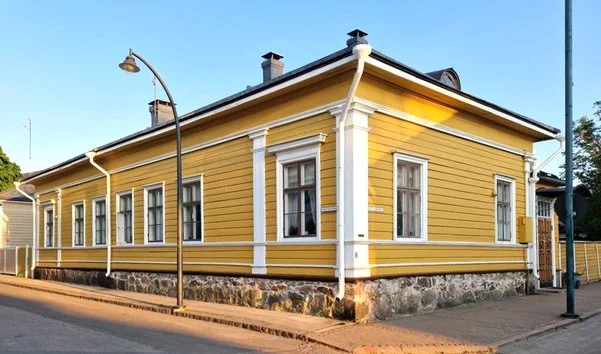
Favre’s House

Favre’s House
The first known information about the plot dates back to the late 1700s, when it was owned by Peter Kiseleff. In 1830, he sold the undeveloped lot to Ivan Kiseleff from Turku. Ivan, in turn, sold it to master bookbinder Carl Haegert and his wife Anna, who built the first part of the current main building in 1843.
The family experienced a great tragedy in August 1853, when two sons and the father all died of cholera within four days. After the father's death, a daughter was born in early 1854, but she also died that same year at the age of 7 months. The widow, Anna Haegert, and her son Carl Witalis Haegert lived in the house until 1858.
In 1859, the house was purchased by the Bruun sisters, Elisabeth and Ulrika, from the Poitsila Manor. Elisabeth lived in the house until 1883, after her sister’s death, when the property was bought by Jules Favre, a French teacher at the Cadet School who was originally from Switzerland, and his wife Amalia. Favre was an energetic man who expanded and renovated the main building into its current late Empire-style appearance. The exterior cladding and windows date from this period, and the extension line is still visible in the stone foundation of the building.
That same year, a new outbuilding was constructed in the yard. It included a woodshed, outhouses, a stable, a carriage shed, and a completely new farmhand's quarters. The gate was also moved to its current location.
In 1889, the house was bought by sawmill manager Gustav Herman Björnström and his wife Olga Maria. Their family included four adult daughters and a son, Jakob, who would later win an Olympic medal in sailing in 1912.
From 1916 onward, the house was owned by primary school teacher Vilkku Joukahainen and his wife Hanna. Joukahainen was a talented and active figure in many fields. In addition to teaching, he edited several newspapers and wrote poems, plays, and fairy tales. His most famous work is likely the poem "On hanget korkeat, nietokset", which was set to music by Jean Sibelius as a Christmas song. Politically active, Joukahainen served as a Member of Parliament and minister between 1917 and 1925.
Businessman Nestori Tulikoura owned the house from 1927 to 1936. During his time, the outbuilding was expanded into its current form.
The property came into the hands of the current owner family in 1936, when Evi and Vihtori Ahola moved in with their families. At that time, there were three separate households in the yard, and families sometimes had tenants as well—schoolchildren during the winter, for example.
Running water, sewerage, and indoor toilets were installed in the main building in 1954. Around the same time, a grand old well in the yard was removed. An apple tree growing on the site is still called the “well tree.” The woodshed, meanwhile, is remembered for the pigs that were kept in a fenced corner, waiting for Christmas. One pig was known to escape into town, prompting the police to call the Aholas: “That pig is sitting on the steps of Vehkalahti Church again!”
The garden remains the heart of the property, and the large apple trees date back to the early 1900s. Other traditional plants also survive in the yard from previous owners.

